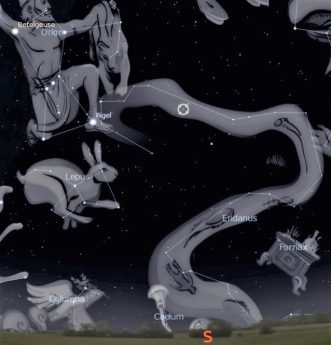This Week’s Sky at a Glance, 2025 Jan 11 – Jan 18
This Week’s Sky at a Glance, 2025 Jan 11 – Jan 18
There is one river seen from New Brunswick that is completely ice-free all winter, but we can only see it on clear nights. Eridanus the River, the fifth largest constellation in area of the sky, has its head just off the foot of Orion near Rigel. Even when it is at its highest in our sky, the river’s meandering path takes it more than ten degrees below the horizon to where it terminates at Achernar, the ninth brightest star.
Although we can’t see Achernar without travelling to Florida, there is a notable star in Eridanus that we can see from outside a city. Omicron-2 Eridani, also called 40 Eridani or Keid (circled on the map), has a famous fictional and fascinating planet: Vulcan, the home of Spock. Did you know that there was once believed to be a planet closer to the Sun than Mercury? It was named Vulcan after the Roman god of fire, metalworking and the forge. Anomalies in Mercury’s orbit were thought to be due to an interior planet, and some astronomers even claimed to have seen it crossing the Sun. The anomalies of Mercury’s orbit were finally explained by some guy named Einstein in his General Theory of Relativity. Coincidentally, regarding the god Vulcan, the constellation Fornax the Furnace barely crests our horizon near Eridanus.
This Week in the Solar System
Saturday’s sunrise is at 8:01 and sunset will occur at 5:03, giving 9 hours, 2 minutes of daylight. Next Saturday the Sun will rise at 7:57 and set at 5:12, giving 9 hours, 15 minutes of daylight.
The Moon is full this Monday and on that evening it occults Mars for 60 to 70 minutes. The planet will slowly disappear behind the Moon around 10:35, but I recommend using binoculars or a telescope starting much sooner as times will vary with location. Without optical aid you will probably lose sight of Mars in the bright moonlight well before the occultation begins. Mars is closest to Earth on Sunday and it reaches opposition on Wednesday, at which time it will make a scenic line with Pollux and Castor, the Twins of Gemini. Meanwhile, Venus moves to within a binocular view of Saturn this weekend, and over the week it will slide past the ringed planet to the right. On Wednesday evening telescope users might see Jupiter’s moon Europa disappear behind the planet at 5:55 and reappear from eclipse at 10:22, and maybe see the Red Spot for two hours centred around 7:15 pm. Mercury rises an hour before sunrise this weekend, and that shortens to 40 minutes by next weekend.
The Fredericton Astronomy Club meets in the UNB Forestry-Earth Sciences building at 7 pm on Tuesday. Tune in to the Sunday Night Astronomy Show at 8 pm on the YouTube channel and Facebook page of Astronomy by the Bay.

